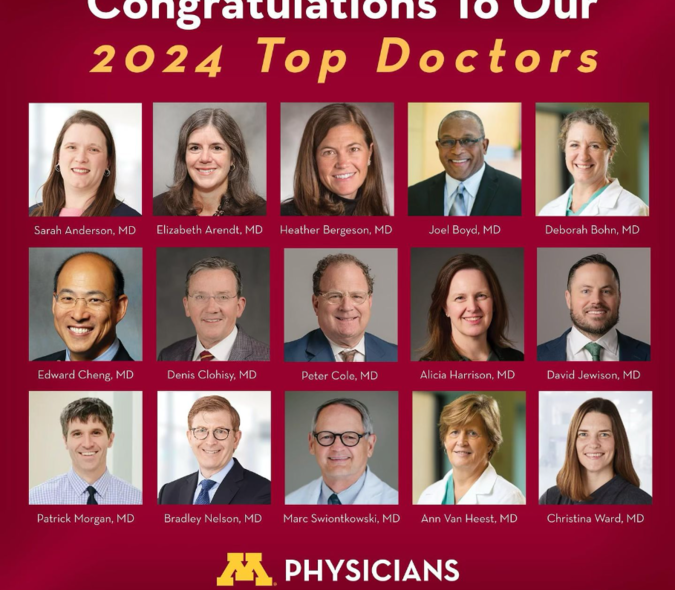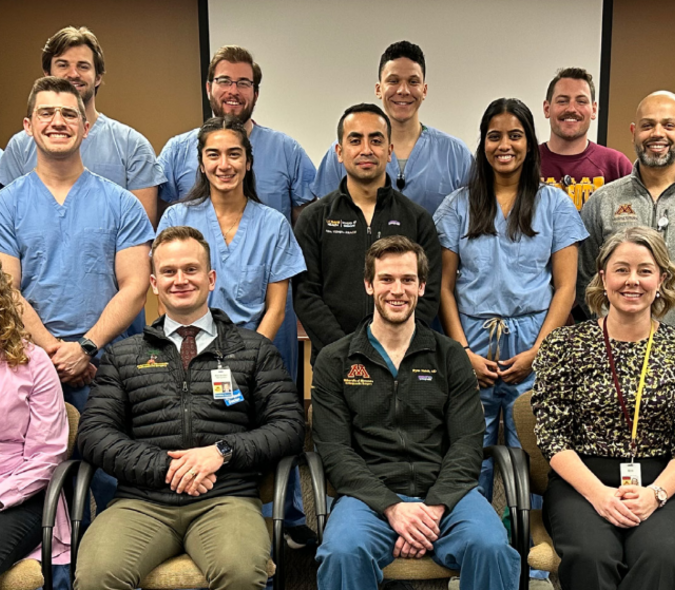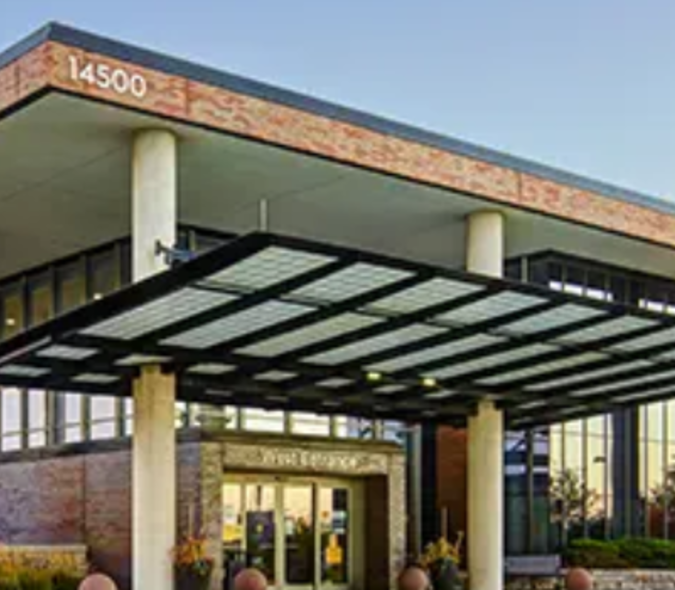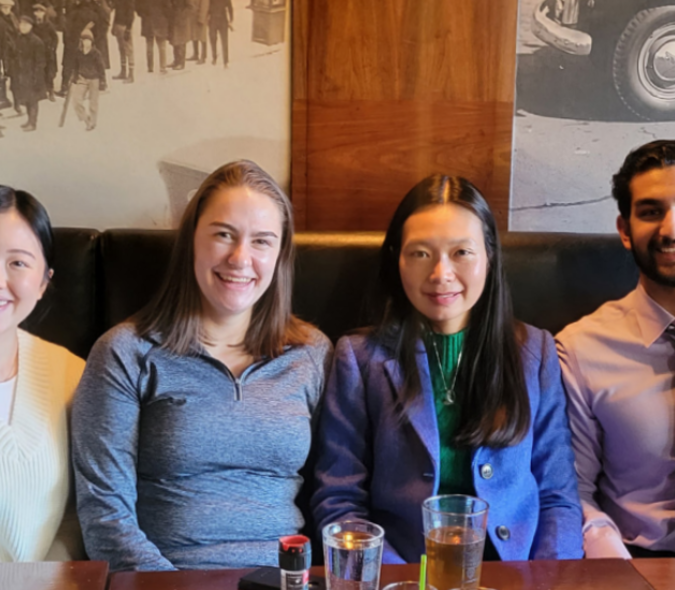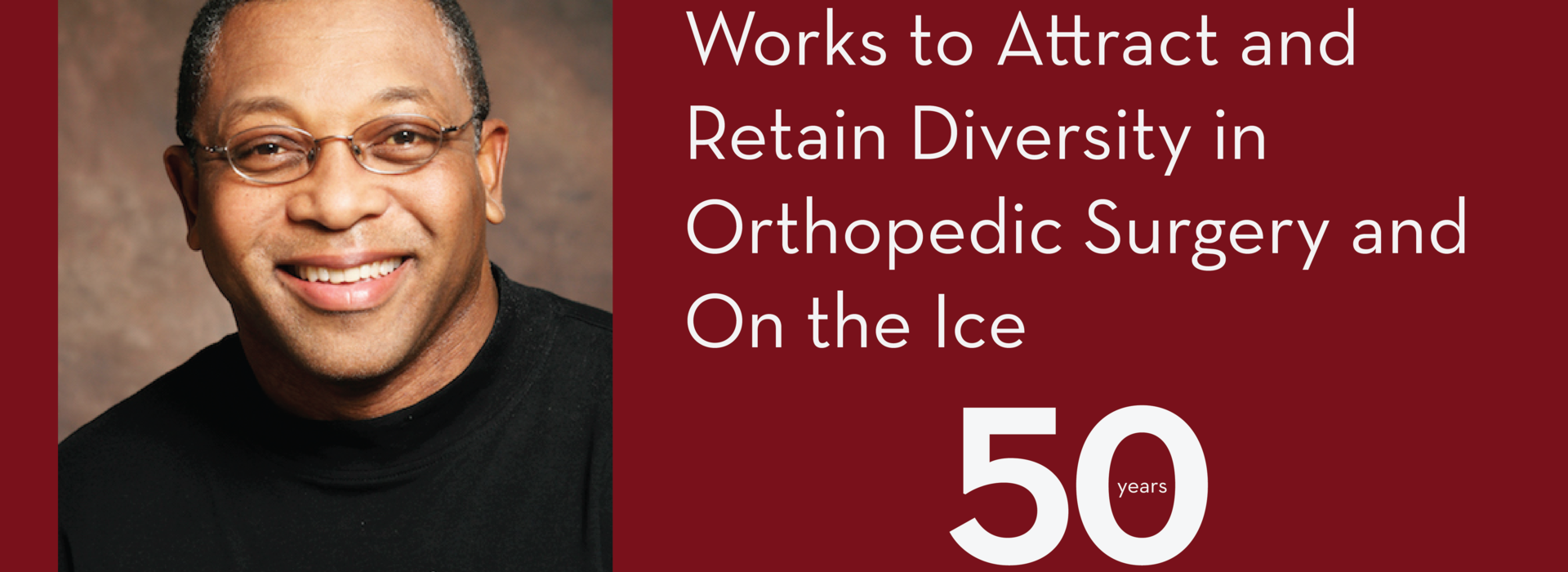
U of M Orthopedist Works to Attract and Retain Diversity in Orthopedic Surgery and On the Ice
JOEL BOYD, MD, ADJUNCT ASSISTANT PROFESSOR and orthopedic surgeon, is no stranger to being a pioneer in industries that aren’t necessarily known for diversity: orthopedics and hockey. He was the first African American orthopedic surgery resident at the Cleveland Clinic and the first NHL (National Hockey League) and second NFL (National Football League) team physician of color. “I had a huge support system and I was very close with the three residents in my class,” he recalls. “Don’t get me wrong, you can’t hide. You certainly ran into missteps by people, but you were on to a bigger purpose, and that was more important.”
While Boyd played football throughout college at Bucknell University in Pennsylvania, his career as an orthopedist would lead him to caring for players on the ice. He became a certified Olympic team physician in 1995, and began working with both the U.S.A. basketball and hockey teams. Boyd worked his way up to head physician for U.S.A. hockey in 1996 and accompanied them to the 1998 Nagano Olympics in Japan. When the Minnesota Wild became a new franchise in 2000, Boyd was an obvious local choice to care for the players.
Boyd has been a Wild team physician for the last 18 years, and has also served as a team physician for University of Minnesota football. In addition, he’s a former Minnesota Vikings and Minnesota Lynx team doctor. While there are many basketball and football players of color, there weren’t many such team physicians in the beginning. Boyd has taken an active role working to increase diversity in his fields of expertise. In partnership with another celebrated African American leader, Bryant McBride (the NHL’s director of new business development), Boyd became involved with an NHL diversity task force called Hockey is for Everyone.
“The idea was to bring hockey to inner cities,” explains Boyd. “As hockey became more expensive and ice not readily available, it was difficult for African Americans to play in this country, especially in the southern states. Therefore, it was natural to gravitate towards football and basketball because there was no availability of ice and hockey equipment.” Hockey is for Everyone supports nonprofit hockey programs around the country and gives kids from all backgrounds the opportunity to try out their skills on the ice. Since 1998, 120,000 children have participated in the program.
Willie O’Ree, the first black NHL hockey player and the league’s diversity ambassador, became the focal point of the task force. Boyd explains that wherever there was an NHL all-star game, the diversity task force would host an event in that city. “We would take disadvantaged kids in the city and treat them like all-stars,” Boyd recalls. “They would get all-star jerseys, have a clinic with Willie, play a game, practice skills, and get to meet all the players. That has continued to this day.”
Boyd was involved in the program for about six years and since then shifted his focus to promoting diversity in the operating room. While a 2018 Journal of the American Medical Association study of medical schools in the U.S. found that racial diversity has increased slowly over the last decade, roughly 60 percent of medical students are still white. In orthopedics, the representational disparities are even more pronounced. “Racial Diversity in Orthopedic Surgery,” published in Orthopedic Clinics of North America, found that African Americans, Hispanic/Latinos, and Native Americans are underrepresented in both residency and AAOS (American Academy of Orthopaedic Surgeons) membership.
Putting it into perspective, only 1.5 percent of AAOS members identify as African American, 1.7 percent as Hispanic/Latino, 6.7 percent as Asian American, and .4 percent as Native American. According to 2016 data from the Accreditation Council for Graduate Medical Education (ACGME), 4 percent of orthopedic surgery residents were African American, 5.4 percent Hispanic/Latino, and 0.2 percent Native American. Meanwhile, Caucasian and Asian American surgeons were overrepresented in orthopedic residencies in comparison with the U.S. population.
While medical schools, residencies, and professional organizations have actively spearheaded programs to recruit and retain diverse students, orthopedics remains a predominantly white specialty. “People are trying to increase diversity, but it’s slow and we wish it would go faster,” Boyd says. “It happens from the top down; you have to hire staff that can be active mentors, that students can see.” Populations of people of color have grown faster in Minnesota than the U.S. average since 2010, according to the 2017 Census. Since numerous studies have demonstrated that employing diverse medical professionals results in better outcomes for patients, it is imperative that medical schools and residencies attract the brightest and most diverse group of students to better serve the patient populations of tomorrow.
As an educator in the Department of Orthopedic Surgery, Boyd is an active mentor. In addition to his clinical and educational duties, he partners with a Chicago-based organization called Nth Dimensions that provides mentorship and resources to underrepresented students in orthopedic surgery. “The program enables medical students in their second year to rotate with African American orthopedic surgeons around the country,” he says. “I’ve had six students rotate with me.”
Nth Dimensions was founded in 2004 by Bonnie Mason, MD, an orthopedic surgeon who was forced to retire early due to health conditions. Nevertheless, her passion for mentorship led her to establish a pipeline program for underrepresented medical students pursuing competitive specialties, including orthopedic surgery. “Each year, we host students from across the country as a summer scholar and a summer intern, which is one of our flagship programs,” explained Sonya Seymour, Nth Dimensions’ Director of Partnerships and Programs. “We place 30 students with physicians located across the United States for mentorship in clinical research, shadowing, and orthopedic exposure, including surgery. The objective is really to diversify medicine. We feel that one of the ways to change disparities in healthcare is by diversifying the workforce.”
Seymour explained that Nth Dimensions is a longitudinal program that provides support to students throughout medical school and into residency. “With the type of mentorship, training, and exposure that we give our students, they’ve matched 90 percent of the time in orthopedics. This is possible through the help of people like Dr. Boyd,” she says. Nth Dimensions provides seminars and workshops tailored to first-year medical students, since it is crucial to expose them to the orthopedic specialty early in medical school.
The programming also gives women a leg up. “What studies have shown is that if women are exposed to orthopedics and realize, ‘I can hold a drill, I can hold a hammer,’ they are more likely to pursue orthopedic surgery,” Seymour says. “One of the challenges for women is that there’s sometimes the perception that orthopedics is not for them, so we provide this exposure to let them know that it is.”
In the Department of Orthopedic Surgery, we are working to create a healthcare workforce qualified to meet the needs of the populations we serve. The department has been a leader in training female residents. While 14 percent of U.S. orthopedic surgery residents are women, the lowest of any surgical specialty, the department has trained 25 percent females over the last decade. Still, there is more work to be done to attract racially diverse candidates.
“Our goal is for the orthopedic workforce to match the populations we serve, because increasing diversity decreases healthcare disparities and improves the care that we provide,” says Ann Van Heest, MD, professor and
residency program director. “While we have made advancements in training a diverse group of students as orthopedic surgeons, our goal is to continue to increase the number of women and underrepresented medical students that choose orthopedic surgery residency training here at the U of M.”
Medical students who complete an orthopedic rotation at the University historically have a higher chance of applying for and placing into our residency program. For the first time this year, the department created an orthopedic scholarship to stimulate applications and interviews from a more diverse group of students. The Visiting Medical Student Scholarship for Underrepresented Populations in Orthopedics offers students a $1,000 stipend for travel and lodging while they complete their University away rotation. The hope is that this will attract more diverse residents to the program early in medical school and increase the likelihood of these residents matching into the program.
While this is an excellent start, Boyd says that the ranking process is also critical because of the abundance of highly qualified candidates. “You want to have residents in the top 10 percent, and you want to have people who have done a lot of research and have unbelievable board scores,” Boyd says. “Then you want to train physicians for the state of Minnesota, and you want women, and you want diversity. There are so many boxes, and you can’t check them all every time. At some point you have to do something that’s not in the box.”
“Tracing the minority experience in orthopedic surgery,” an article published in Orthopedics Today, suggests that there’s a general “overlapping syndrome” that occurs when several residencies rank the same (highly competitive) underrepresented applicant and don’t rank any others. While these applicants will match, the rest may go unmatched and pursue a less competitive specialty, perpetuating the lack of diverse orthopedic surgeons. “Two things have to happen. If they decide to rank the U number one, that might be okay as long as the five to six residents above them didn’t,” Boyd says. “If they don’t rank us number one, it’s probably not going to happen. Again, both things have to happen; they have to want to come here, and if we want this to work, we have to put them in the top three. At some point, when a person pretty much checks the boxes as far as what we want in a resident, we have to be willing to say, ‘there’s a higher purpose here, we need to rank them higher.’”
While the National Residency Matching Program has made the matching process more equitable, Boyd says that placing diverse residents still comes down to the numbers. “I think it’s better for everyone and it does improve patient care overall,” Boyd says. “That’s why we are fighting for this.”
